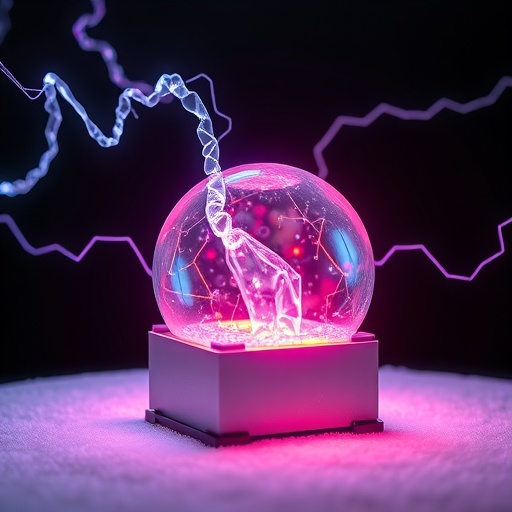In recent years, the quest for efficient and environmentally friendly solid-state cooling technologies has intensified, drawing significant attention toward materials exhibiting pronounced electrocaloric effects (ECE). The electrocaloric effect, a thermodynamic phenomenon where a material undergoes an adiabatic temperature change in response to an applied electric field, holds promising potential for next-generation refrigeration systems. A groundbreaking study led by Du, Yang, Hao, and colleagues has unveiled a novel class of lead-free perovskite oxides that achieve a giant electrocaloric response by harnessing the power of high polar entropy within complex lattice architectures.
Central to this innovation is the strategic engineering of perovskite ferroelectric materials, long celebrated for their exceptional dielectric properties and intrinsic coupling between lattice polarization and external stimuli. Traditional perovskite ferroelectrics typically manifest highly ordered polar domains, which constrain the achievable electrocaloric performance due to limited configurational entropy. This new research circumvents such limitations by introducing deliberate multielement substitutions at both A and B crystallographic sites, orchestrating a high-polar-entropy state characterized by disordered yet dynamically tunable polar configurations.
The significance of polar entropy in enhancing electrocaloric effects cannot be overstated. By fostering multiple nanoscale polar variants alongside non-polar regions, the researchers have crafted a material microstructure replete with polymorphic polar heterogeneity. This intricate lattice distortion fosters a dense network of internal interfaces and domain boundaries, which collectively augment the material’s configurational entropy. Such an entropy-rich state facilitates a more substantial adiabatic temperature change when subjected to an external electric field, thereby amplifying the electrocaloric response beyond conventional perovskite ferroelectrics.
Intriguingly, the lead-free relaxor ferroelectric developed in this study delivers an entropy change approximating 15 joules per kilogram per kelvin under an electric field strength of 10 megavolts per meter. This remarkable figure not only surpasses many established electrocaloric materials but also persists stably over an extensive temperature window exceeding 60 degrees Celsius. The broad operational range addresses a critical challenge in commercial electrocaloric refrigeration applications, where narrow effective temperature spans often impede practical utility.
The material’s exceptional performance arises from ultrafine, dispersed multiphase lattice architectures, which are achieved through the targeted incorporation of multiple ionic species at A and B sites within the perovskite structure. This multi-ion substitution induces complex atomic-scale distortions, creating a mosaic of polar domains varying in orientation, size, and symmetry. Such polymorphic diversity is pivotal for empowering a flexible polar landscape that can readily respond to external electric stimuli with substantial entropy variations.
Moreover, the high-polar-entropy state in this perovskite oxide not only elevates ECE values but also endows the material with enduring cyclic stability, demonstrated over more than one million electric field cycles. This longevity is a remarkable advancement, addressing long-standing reliability concerns that have hindered the deployment of electrocaloric materials in commercial multilayer ceramic capacitors (MLCCs). The robust fatigue resistance coupled with enhanced ECE positions this oxide as a prime candidate for scalable solid-state cooling technologies.
The implications of this research extend beyond materials engineering into sustainable refrigeration technology. Traditional vapor-compression refrigeration methods rely heavily on high global warming potential refrigerants, provoking urgent demand for greener alternatives. Solid-state electrocaloric devices offer a path toward silent, compact, and environmentally benign cooling solutions. The presented high-polar-entropy perovskite oxides are poised to accelerate this transition by combining strong performance with practical fabrication pathways via ceramics processing.
This study also reinforces the evolving paradigm in functional ferroelectric materials design, where controlled disorder and complex domain engineering are no longer viewed as defects to be minimized but rather as deliberate attributes harnessed to amplify material functionalities. The successful manipulation of local polar disorder to generate advantageous high-entropy states exemplifies this shift and offers a blueprint for future explorations of other ferroic and multiferroic systems.
At the atomic scale, the researchers employed advanced characterization techniques to elucidate the nature of the induced lattice distortions. Methods such as high-resolution transmission electron microscopy (HRTEM) and synchrotron-based X-ray diffraction revealed the coexistence of nano-sized polar clusters interspersed within non-polar matrices. This heterogeneous structure underpins the observed electrocaloric enhancement, highlighting the importance of nanoscale engineering in optimizing material properties.
From a thermodynamic perspective, the coupling of configurational entropy with electric field-induced polarization switching is key to realizing the large entropy and temperature changes characteristic of this work. The entropy gain associated with reorienting a multitude of subtle polar variants adds a substantial entropic driving force that conventional, highly ordered ferroelectrics cannot easily match. This entropic contribution marks a fundamental advance in electrocaloric materials science.
Looking forward, the integration of such high-polar-entropy perovskite oxides into multilayer ceramic capacitors enables transformative possibilities for compact and scalable refrigeration modules. These MLCC-based devices could achieve rapid heat pumping capabilities with low power consumption, essential for electronics cooling, climate control, and even medical applications. Moreover, the lead-free chemistry aligns with global trends favoring environmentally safer materials.
In conclusion, the emergence of giant electrocaloric effects in multielement-substituted, high-polar-entropy perovskite oxides represents a major leap toward practical solid-state cooling technologies. By embracing polar disorder and complex multiphase lattice structures, this study refines the fundamental mechanisms governing ECE, opening new pathways for both scientific inquiry and technological innovation. As further research explores optimization and device integration, these materials stand poised to reshape the future landscape of sustainable refrigeration.
Article References:
Du, F., Yang, T., Hao, H. et al. Giant electrocaloric effect in high-polar-entropy perovskite oxides. Nature (2025). https://doi.org/10.1038/s41586-025-08768-8
Image Credits: AI Generated




